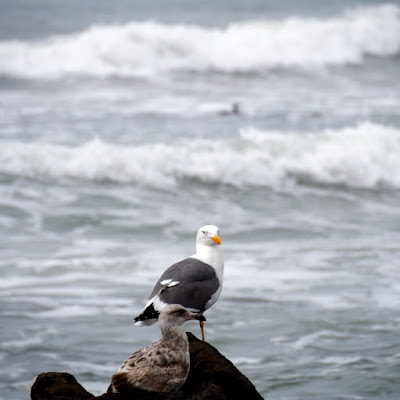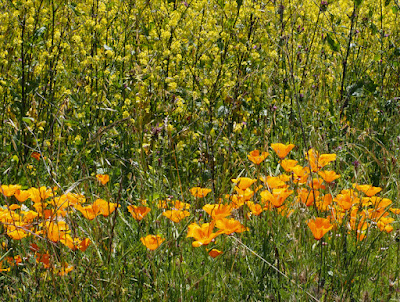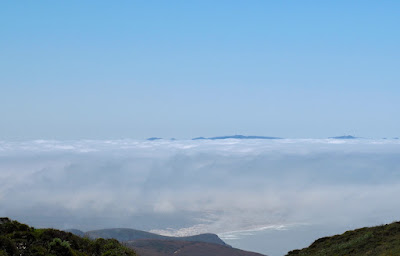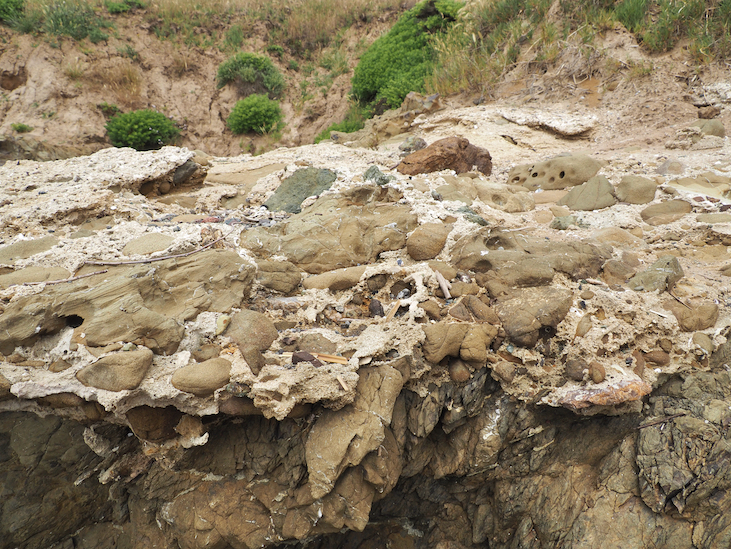"I gazing at the boundaries of granite and spray, the established sea-marks, felt behind me
Mountain and plain, the immense breadth of the continent,
before me the mass and doubled stretch of water."
Those are not my words. Robinson Jeffers wrote them a century ago. But that's very much how I felt after driving across the Rocky Mountains, Colorado Plateau, Great Basin, Mojave Desert, Central Valley, and Coast Range to reach the "Continent's End" as Jeffers called it. He loved this rugged coast with off and on fog—a place where we can "unhumanize our views a little, and become confident, as the rock and ocean ... "
 |
| Estero Beach State Park north of Cayucos, in intermittent fog. |
 |
| Herring Gulls probably (note pink leg). |
Cormorants were cooperative, hardly moving while I played with my new camera and lens.
 |
| Seabirds as sculpture. |
My friend showed me a curious erosion-resistant white deposit near the base of the bluffs.
Geotripper Garry Hayes says it's calcite, perhaps from a spring. What do you think?
 |
| This one is harder to explain ;) |
The next day, I hiked up the Point Sal road south of Guadalupe. It climbs steeply, and then winds down down down to Point Sal State Beach. The road is closed to motorized vehicles, is dirt much of the way, and is quite rough in places. Hard to imagine going to Point Sal in the family station wagon! But that's what we did.
 |
| Looking down from the Point Sal road; trailhead is white spot in lower left quarter. |
The hills were still green (normally brown by now) and plants were flourishing, thanks to torrential rains earlier in the year.
 |
| The beloved and the despised: orange California Poppy and yellow Black Mustard (actually, some people like the yellow patches the mustard adds to our grasslands). |
I spotted several giant thistles along the road—about six feet tall! This is the non-native Blessed Milkthistle. It's listed Noxious in some parts of the country, but the
California Invasive Plants Council considers it of limited concern, with low rates of invasion and minor ecological impact. I was taken by its dramatic features, especially the boldly mottled leaves.
 |
| Silybum marianum. |
I turned around at the crest, far above Point Sal beach. Views down can be spectacular, but that day they were mostly hidden by fog—the ocean's breath (channeling Jeffers again).
 |
| Looking south with a bit of ocean and strand visible below the fog bank. |
 |
| The rugged north end of Point Sal beach ... a view I will never tire of! |

















So exciting you came here! It's my home territory (broadly speaking)! Your photos are beautiful. I just returned yesterday from a 4-day backpack in Point Reyes National Seashore, just north of San Francisco, so I'm brimming with scenes of fog, rocks, and ocean - even saw whales! Some sunny blue periods as well, it wasn't all fog all the time. And yes, greenness and immensely high (and ticky) grasses and flowers much later than normal this year. Pt. Reyes has some cool rock outcrops, and beautiful twisted and folded strata in some of the coastal cliffs, I always wish a geologist were along with me to explain it all.
ReplyDeleteHmm, don't know why I came out as "anonymous" in my comment just now! I've been "Ingridcc" or "loopbraider" in previous comments. I really enjoy your blog.
ReplyDeleteHello Ingrid, thank for visiting and commenting, and for "revealing" yourself. Who knows why such things happen! Your trip to Pt. Reyes sounds wonderful ... and so similar in terms of conditions. For some reason no ticks landed on me, tho' conditions certainly were conducive.
DeleteBtw, I was told once that I was lucky to learn geology in Wyoming ... it's so much simpler than in California, especially along the coast.
Hollis,
ReplyDeleteHave you read McPhee's *Rising From the Plains?* In it he describes how most geologists are most familiar with their own backyards, but the Wyoming people, who're frequently versed in divining oil, are, by virtue of oil's unique properties, often endowed with a greater breadth of knowledge than their colleagues.
Hello MFH. Yes, I've read it several times. I can't say he's right or wrong on that. I just know I'm glad I got into geology (for "fun" not profession) in WY where it's fairly straightforward and visible. Vs. California where it's so puzzling with those great plates jostling around!
DeleteHi Hollis,
DeleteI found your website looking for information on the snowy range fuchsite. What a lovely little blog from a kindred spirit. I'm 29, so I've just been cracking open the world of naturalism for the last few years. I lived on the central coast for ten years. Now I live on the Front Range down in CO. It's funny you say that Wyoming geology is simple and well-exposed and California geology is convoluted. I feel exactly the opposite! I often tell my friends that California geology is so much easier than Rocky Mountain regional geology. The tectonics are active. Everything that is happening is on display in the present. If you want to understand a plate boundary, you can walk up to the San Andreas and along its bends. If you want to understand subduction, you can go to Lassen and Shasta. If you want to understand normal faults, you can go to the Mojave and see the basins and ranges. Oceanic plate on continental plate? There are beaches with beautiful outcroppings of old Farallon plate with turbidites and continental granite. Everything is visible. The Rockies are super old by comparison. Everything is stacked on top of everything else, and it's all super eroded. Minerals are important for unwravelling the history of the Rockies, whereas in California you can just look at a map and the living geomorphology speaks for itself. It's just interesting to me to hear you say the opposite! I find dynamic geology easier to understand than static, ancient landforms
Hey there Lucas, thanks for visiting and for the interesting comment! I'll get back to you by email.
ReplyDelete